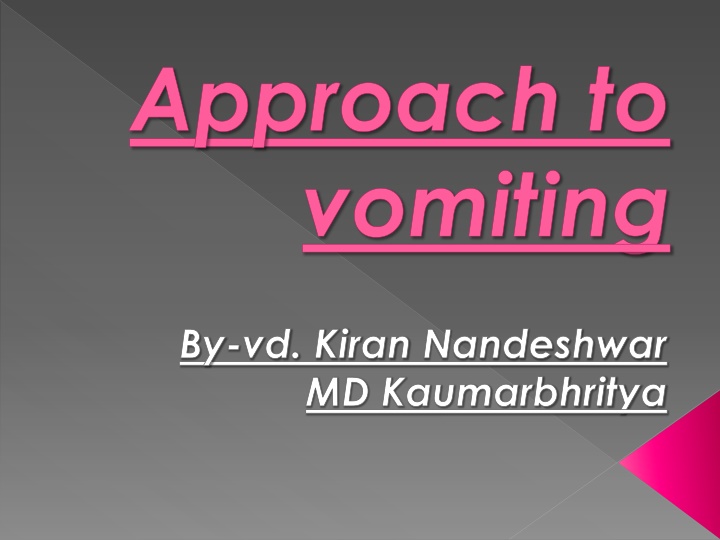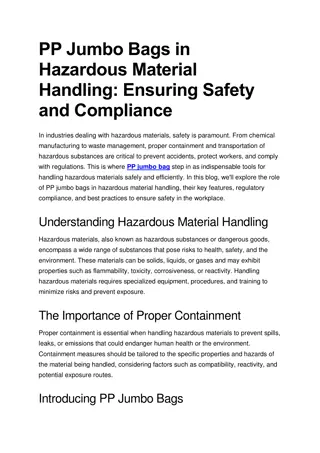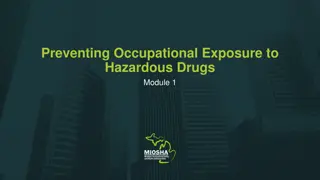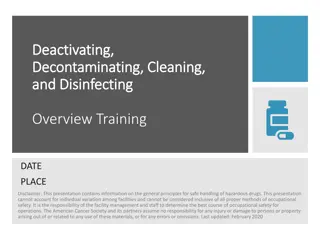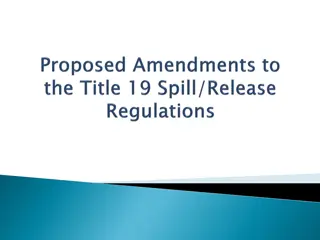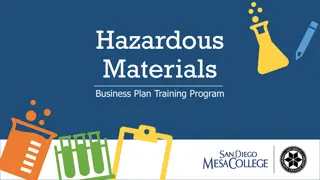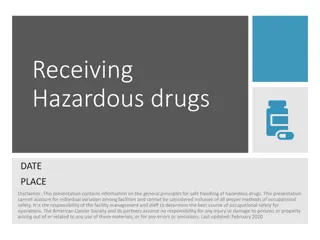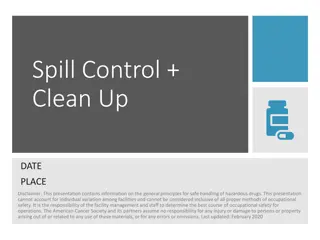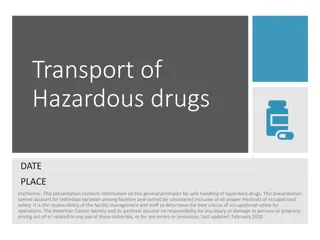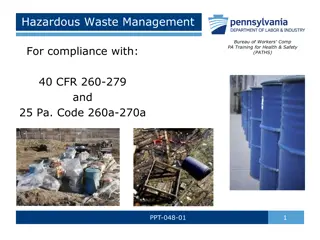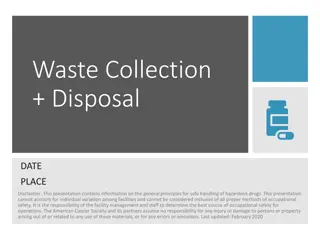Safe Handling of Hazardous Drugs in Healthcare Facilities
This presentation provides information on the safe handling of hazardous drugs, particularly focusing on the risks associated with human excreta of patients receiving chemotherapy. It covers the importance of personal protective equipment, precautions during collection and disposal, ways to reduce exposure, and recommendations for protecting the skin. Nurses and physicians administering chemotherapy drugs should take this training to ensure occupational safety.
Uploaded on Mar 06, 2025 | 1 Views
Download Presentation

Please find below an Image/Link to download the presentation.
The content on the website is provided AS IS for your information and personal use only. It may not be sold, licensed, or shared on other websites without obtaining consent from the author.If you encounter any issues during the download, it is possible that the publisher has removed the file from their server.
You are allowed to download the files provided on this website for personal or commercial use, subject to the condition that they are used lawfully. All files are the property of their respective owners.
The content on the website is provided AS IS for your information and personal use only. It may not be sold, licensed, or shared on other websites without obtaining consent from the author.
E N D
Presentation Transcript
Approach to vomiting By-vd. Kiran Nandeshwar MD Kaumarbhritya
defination Involuntary, forceful expulsion of the content of stomach through mouth and sometimes nose
Pathophysiology of vomiting Final part of sequence of events coordinated by the emetic center located in the medulla. Emetic centre can be activated by afferent neural pathways from : 1. digestive 2. non-digestive 3. chemoreceptor trigger zone 4. other CNS system
Act of vomiting A deep breath raising of the hyoid bone and larynx to pull the upper oesophageal sphincter open Closing of the glottis to prevent vomitus flow into the lungs Lifting of the soft palate to close the posterior nares Strong downward contraction of the diaphragm along with simultaneous contraction of all the abdominal wall muscles
This squeezes the stomach between the diaphragm and the abdominal muscles, building the intragastric pressure to a high level. Finally the lower esophageal sphincter relaxes completely , allowing expulsion of gastric contents up through the oesophagus
evaluation Assessment of severity: 1. presence of dehydration 2. hypokalemia 3. hypochloremia 4. metabolic acidosis 5. malnutrition Diagnosis of cause Surgical or life threatening cause
History of present illness Time of starting Frequency Character of episodes Pattern of vomiting
Associated symptoms Diarrhoea Fever Anorexia Abdominal pain
Review of system Metabolic disorders: weakness, poor suck, failure to thrive. Intestinal obstruction: delay in passage of meconium, abdominal distension, lethargy. Intracranial disorder: headache, nuchal rigidity, vision change.
Physical examination Vital signs Volume depletion Signs of distress Head and neck examination Cardiac examination Abdominal examination Skin examination
Vomiting in neonates Vomiting/ regurgitation is relatively frequent symptom during the neonate period. Most of the time unimportant and may rarely persist beyond the first few feeds. But sometimes vomiting is significant.
Insignificant vomiting in neonates Small frequent vomits posits. Neonates normally spit up small amounts during or soon after feeding, often when being burped. Rapid feeding, air swallowing and overfeeding may be the cause. Occasional vomiting may also be normal , but repeated vomiting is abnormal.
Significant vomiting in neonates Vomit contains blood. The vomit is bile. Projectile vomiting. The baby is unwell. The baby is failing to thrive. The baby has gastrooesophageal reflux and could be aspirating. The baby also has diarrhoea.
The abdomen is distended. Delay in passage of meconium. The baby is dehydrated.
Bloody vomit Blood swallowed during birth. Blood swallowed during breastfeeding. Baby is bleeding. Vigorous suctioning.
Vomiting bile Suspect bowel obstruction if bile is green CAUSES: 1. volvulus 2. hirschsprung disease SIGNS OF OBSTRUCTION: Abdominal distension Bloody stool
Vomiting in infants CAUSES SUGGESTIVE FINDINGS DIAGNOSTIC APPROACH Viral gastroenteritis Usually with diarrhoea Sometimes fever h/o contact with similar patient Recurrent fussiness during or after feeding Rapid immunoassay for viral antigens Gastroesophageal reflux disease Possibly poor weight gain Arching of the back Recurrent respiratory symptoms Empiric trail of acid supression Upper GI contrast study Milk scan Esophageal pH endoscopy
CAUSES SUGGESTIVE FINDINGS DIAGNOSTIC APPROACH Bacterial enteritis or colitis Usually with diarrhoea Often bloody, fever Crampy Abdominal pain, distension h/o of contact with similar patient Stool examination for WBC and culture Pyloric stenosis Reccurent projectile vomiting immediately after feeding in neonates aged 2-12 weeks Infrequent stools May be emaciated or dehydrated Sometimes palpable olive in right upper quadrant Ultrasonography of pylorus Upper GI contrast study
CAUSES SUGGESTIVE FINDINGS DIAGNOSTIC APPROACH Congenital atresias or stenosis Bilious emesis in first 24- 48 hr of life Sometimes polyhydromnios during pregnancy Down syndrome jaundice Colicky abdominal pain, inconsolable cry, lethargy, drawing of legs upto the chest Later bloody current jelly stools Typical age-3-36 months Abdominal X-ray Upper GI series or contrast enema intessusception Abdominal ultrasonography Air or contrast enema(unless patient has signs of peritonitis or perforation
CAUSES SUGGESTIVE FINDINGS DIAGNOSTIC APPROACH Hirschsprung disease In neonates delayed passage of meconium Abdominal distension, Bilious vomiting Abdominal X-ray Contrast enema Rectal biopsy Malrotation with volvulus In neonates, bilious emesis, Abdominal distension and pain Bloody stool Abdominal X-ray Contrast enema or upper GI series
CAUSES SUGGESTIVE FINDINGS DIAGNOSTIC APPROACH sepsis Fever, lethargy, tachycardia, tachypnoea, Widened pulse pressure, hypotension Cell counts and culture Chest X-ray if pulmonary symptoms are present Food intolerence Abdominal pain and diarrhoea, Possibly eczematous rash or urticaria Elimination of diet Skin testing Radioallergosorbant testing (RAST)
CAUSES SUGGESTIVE FINDINGS DIAGNOSTIC APPROACH Metabolic disorder Poor feeding, Failure to thrive, Lethargy, Hepatospleenomegaly jaundice, Sometimes unusual odor, cataracts Electrolytes, ammonia, Liver function test, BUN, creatinine, serum glucose, serum bilirubin, CBC, PT/PTT Neonatal metabolic screening
RED FLAGS Bilious vomiting Lethargy or listlessness Inconsolability and bulging fontanelle in infant Nuchal rigidity and photophobia , fever in older children Peritoneal signs and distension Persistent vomiting with poor growth or development
Vomiting in children and adolescents CAUSES SUGGESTIVE FINDINGS DIAGNOSTIC APPROACH Viral gastroenteritis Usually with diarrhoea Sometimes fever, h/o contact with similar patient Rapid immunoassay for viral antigens Bacterial enteritis or colitis Usually diarrhoea(often bloody), fever, crampy abdominal pain, distension, fecal urgency h/o contact with similar patient Stool for WBC, culture
CAUSES SUGGESTIVE FINDINGS DIAGNOSTIC APPROACH Non-GI tract infection Fever Often localising findings(headache, ear pain, sore throat, cervical adenopathy, dysuria, flank pain, nasal discharge Depending on cause Initial general malaise and periumbilical discomfort followed by pain in right lower quadrant, vomiting after pain manifestation, anorexia, tenderness at mcburney point, decreased bowel sounds Testing as needed for suspected cause Appendicitis ultrasonography
CAUSES SUGGESTIVE FINDINGS DIAGNOSTIC APPROACH Serious infection 1.Fever, toxic appearance, back pain, dysuria (pyelonephritis) 2. Nuchal rigidity, photophobia (meningitis) 3. listlessness, hypotension, tachycardia (sepsis) Cell counts culture ( blood, urine CSF) as indicated by findings Intracranial hypertension (caused by tumor or trauma) Chronic, progressive headache, nocturnal awakening, morning vomiting, headache worsened by coughing or valsava maneuver, vision changes Brain CT
CAUSES SUGGESTIVE FINDINGS DIAGNOSTIC APPROACH Cyclic vomiting More than or equal to 3 episodes of intense acute nausea and constant vomiting and sometimes abdominal pain or headache lasting hours to days Intervening symptom free intervals lasting weeks to month Binge and purge cycle, erosion of tooth enemal, weight loss or gain Sometimes skin lesion on hand from inducing vomiting (russels sign) Exclusion of metabolic, GI, malrotation or CNS disorder Eating disorder Clinical evaluation
CAUSES SUGGESTIVE FINDINGS DIAGNOSTIC APPROACH pregnancy Amenorrhea, morning sickness, bloating, breast tenderness Urine pregnancy test Toxic ingestion (eg. Acetaminophen, iron, ethanol) Often history of ingestion, various finding depending on ingested substance Qualitative and quantitative serum drug levels Adverse drug reaction Exposure to specific drug Clinical evaluation
TREATMENT Promethazine Prochlorperazine Metoclopramide ondansetron
promethazine H1 receptor blocker (antihistamine) Inhibits the emetic centre response to peripheral stimulants Dose: 0.25 1 mg /kg Route: PO, IM, IV, PR q 4-6 hr Side-effects: respiratory depression and sedation
prochlorperazine Weak dopamine receptor blocker that depresses the chemoreceptor trigger zone Dose: 0.4 mg /kg Route: oral q 6-8 hr. IM dose is half Side-effects: extrapyramidal symptoms or orthostatic hypotension
metoclopramide Dopamine receptor antagonist that acts both centrally and peripherally by increasing gastric motility and decreasing afferent impulses to chemoreceptor trigger zone Dose: 0.1mg/kg Route: oral, IM, IV q 6-8 hr Side-effect: extrapyramidal symptoms
ondansetron Selective serotonin (5-HT3) receptor blocker that inhibits the initiation of vomiting reflex in the periphery. Single dose safe and effective children with gastroenteritis not responding to oral rehydration therapy Dose: 0.15-0.45mg/kg Route: IV, oral Side-effects: repeated dose cause persistent diarrhoea
